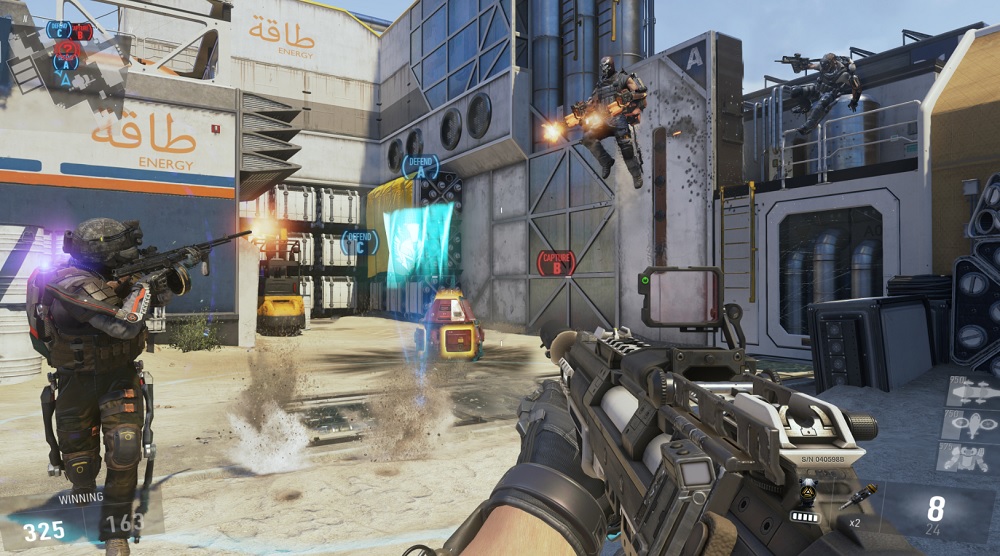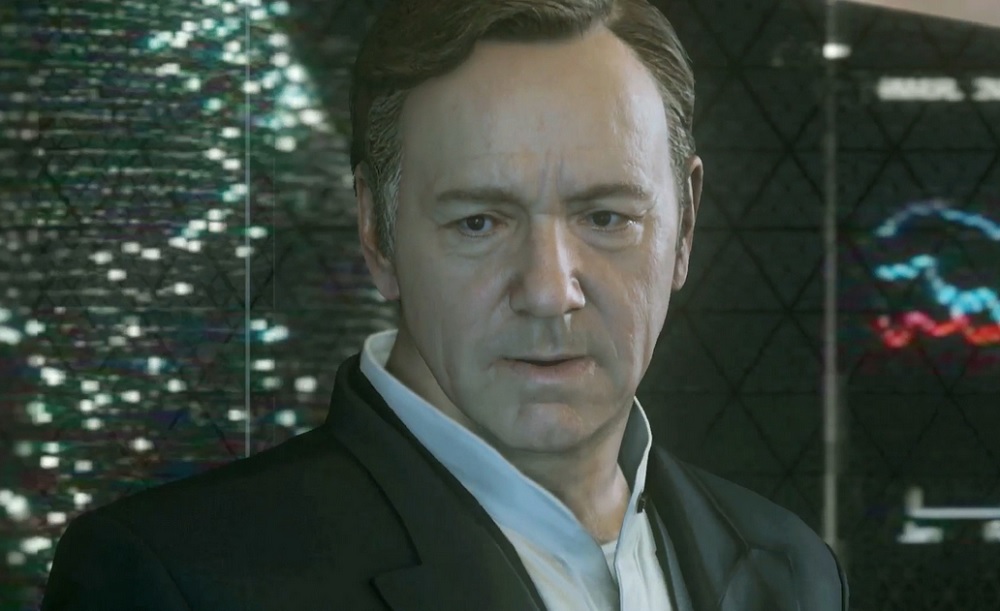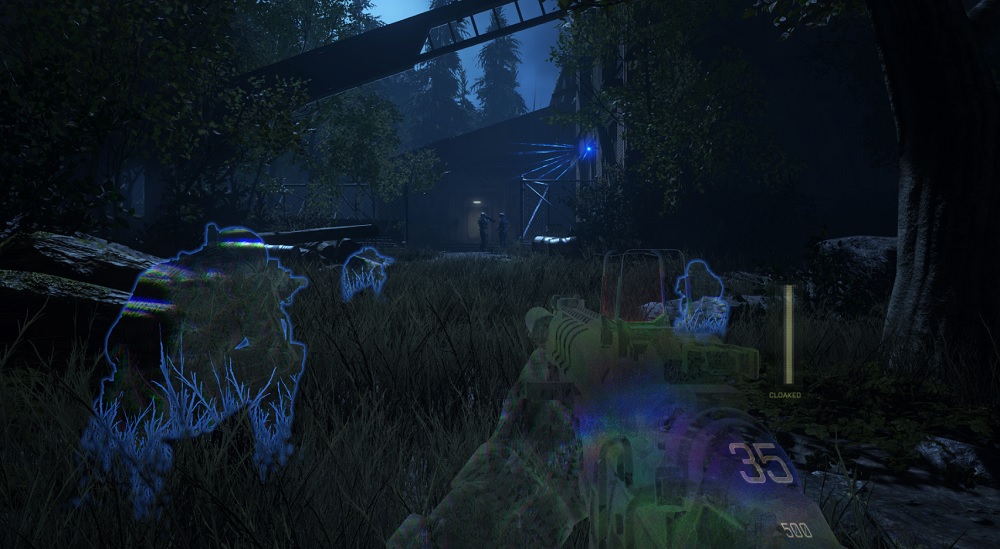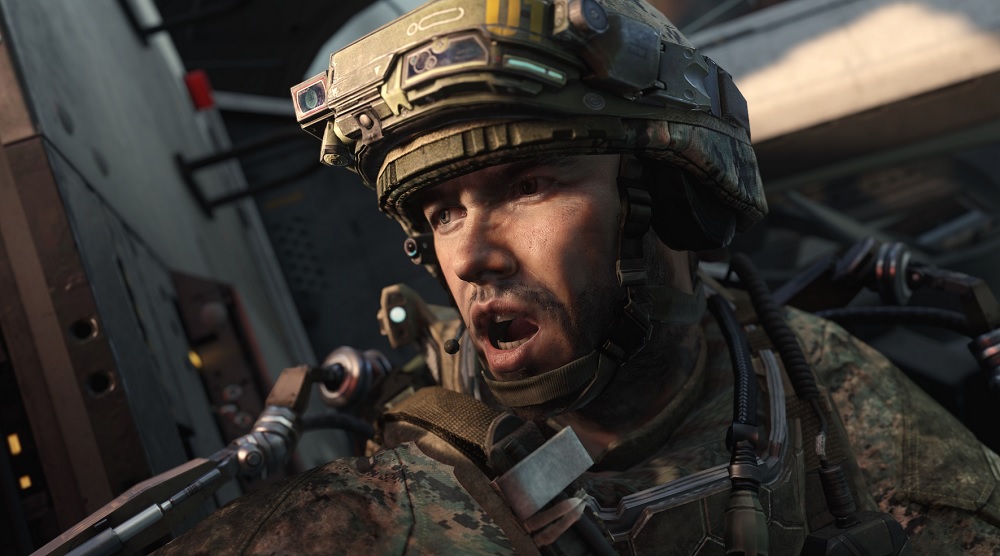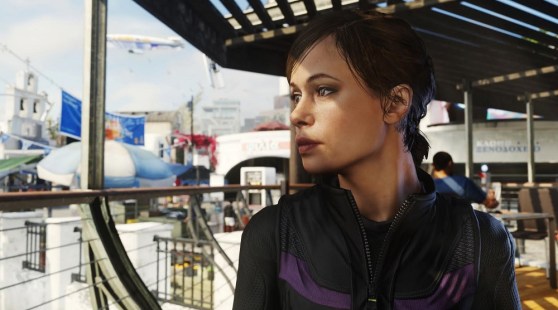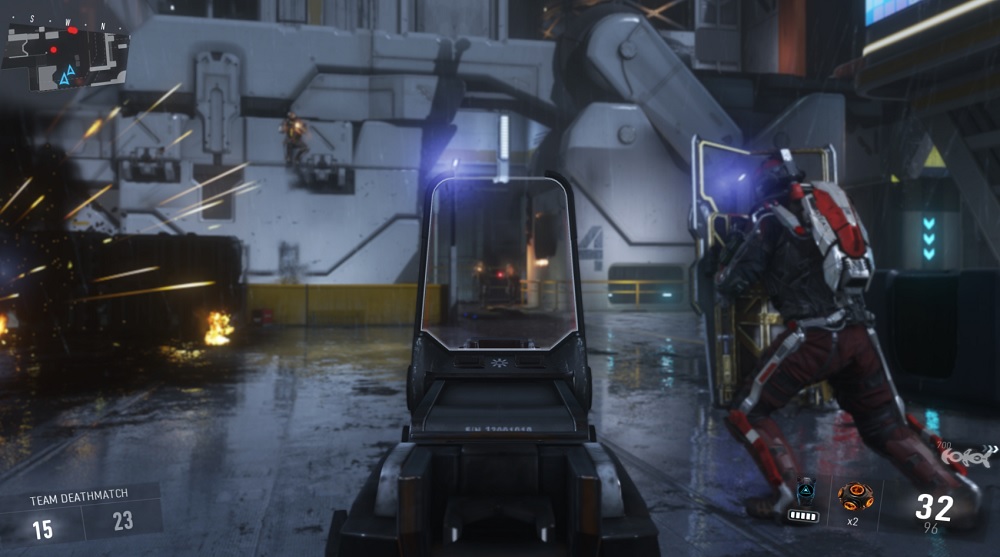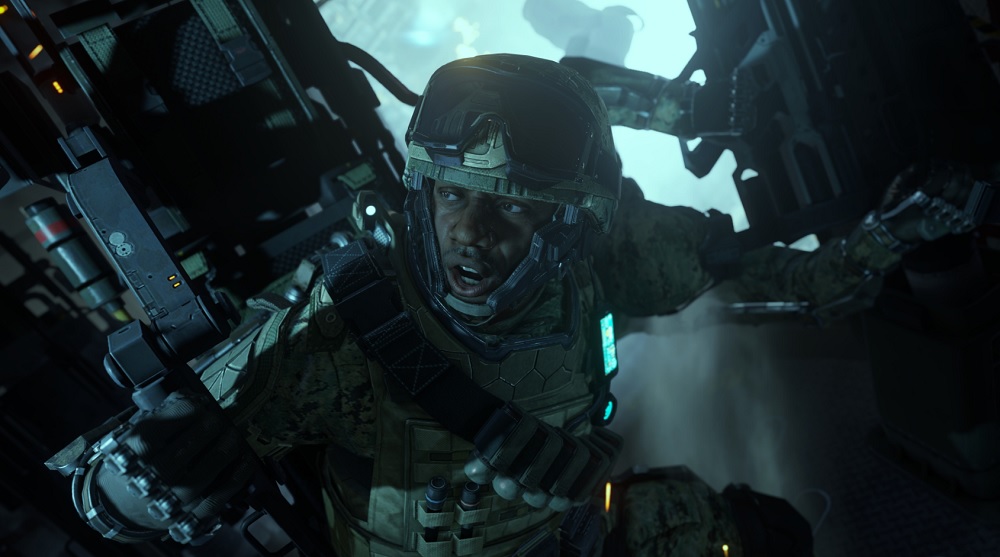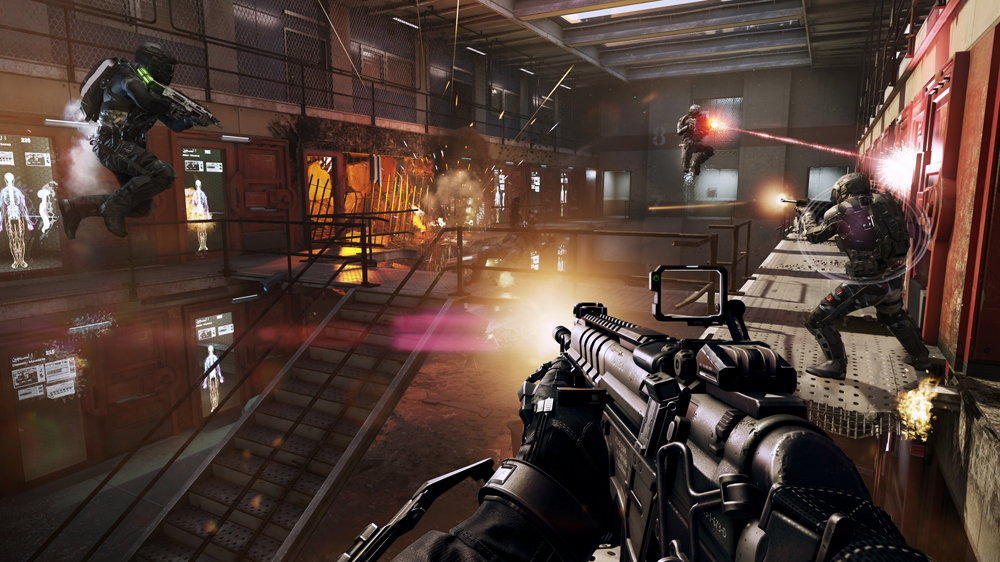This review has some limited story spoilers and focuses on the single-player aspect of Call of Duty: Advanced warfare. GamesBeat will run a later review of the multiplayer after release. –Ed.
Check out our Reviews Vault for past game reviews.
Lots of people are trying to predict the downfall of Call of Duty, particularly analysts who are worried about Activision Blizzard’s stock price. Someday, they figure, the 40 million who play the games every month are going to get tired of it. Battle fatigue and gravity have to kick in.
But the naysayers tend to forget one thing. Call of Duty is fun and engaging, and that’s why they sell more than a billion dollars’ worth of games every year: That’s still the case with Call of Duty: Advanced Warfare, the 11th major installment in the first-person military combat game series coming to the PlayStation 4, Xbox One (reviewed here), PlayStation 3, Xbox 360, and PC. The series has generated more than $10 billion in revenue and sold more than 175 million games, making it perhaps the highest-selling hardcore game series next to Grand Theft Auto. Disappointment in this context is a relative term: If it sells less than 20 million copies, Advanced Warfare will be a disappointment. But having played it, I still like it. And I think this year’s Advanced Warfare is better than last year’s Call of Duty: Ghosts. Last year’s Call of Duty was supposed to usher in the next-generation of gaming, but this one from Sledgehammer Games really feels like the real thing.
Call of Duty: Advanced Warfare takes the modern combat series far enough into the future — the years 2051 to 2061 — to be considered science fiction. By coming up with a dramatic story set in the future and weapons that take high-tech lethality to a new level, Sledgehammer Games is making an impressive entry as a developer of Call of Duty games. The franchise is now rotating each year among Sledgehammer, Infinity Ward (which made last year’s Call of Duty: Ghosts), and Treyarch, maker of Call of Duty: Black Ops II.
With three years to work on it and a new 225-person studio in Foster City, Calif., Sledgehammer has supplied some much-needed reinforcements for the brand. By moving Call of Duty into the future, it could create new characters, new weapons, and new kinds of threats to the unstable world’s political order. The game starts in Seoul in 2051, where the hero, Jack Mitchell, has his baptism of fire in the U.S. Marine Corps as North Korea invades the South. Then the story leaps to 10 years later, with Mitchell fighting for Atlas, a private military corporation.
That’s when the story slows down and you learn more about the state of the world, and it feels like you’re going to get more from the story than just the glue in between a series of scenic firefights. Sledgehammer Games has gone a long way toward fixing what was wrong about the Call of Duty series, particularly by getting rid of the excessive numbers of characters and complicated plot twists. This time, there’s a good guy, a bad guy, another bad guy, and a few sidekicks. Some will betray you. Others will be loyal.
What you’ll like
The exoskeleton adds the right amount of superhuman power
The “exoskeleton suit” is the main new contribution to the military’s capabilities in 2051, enabling soldiers to leap to the top of a building in a single bounce. Created by military contractors like the Atlas Corp., the suit makes the individual soldier both more powerful and harder to kill. You can wipe out a whole bunch of enemies, but supersoldiers on the other side represent a big threat to you in multiplayer. The exoskeleton resembles the armored soldiers in games like Titanfall and Halo, but the setting is not so distant from the real world, so you get the science fiction weaponry of futuristic games with the gritty realism and political intrigue of a modern-day Call of Duty game.
The Exo suit gives you superhuman strength in your arms too. You can rip a door off a car and use it as a shield to block a hail of bullets. Then you can throw it with deadly force at an enemy. In past Call of Duty games, you could always run at 40 miles per hour nonstop. It sort of felt ridiculous as you sped through maps so fast that the enemies couldn’t draw a bead on you. Now there’s a reason why you can run so fast or jump so high — the suit.
But if you play on “Hardened” or higher, you’ll find that it’s still suicidal to start jumping into fray with no regard for cover. If you jump indoors by mistake, you’ll bonk your head on the ceiling. If you’ll an inept player, the exoskeleton can hurt you. The exoskeleton can get you out of a tight spot and give you a tactical advantage on the offense, but it won’t save you from crack enemy shooters.
Kevin Spacey is a good villain
Sledgehammer’s team worked on Electronic Arts’ Dead Space, a survival-horror game series with deep and well-paced stories. Advanced Warfare isn’t just nonstop fighting. You have to operate in stealth mode in some missions, such as a covert operation in Detroit or a game of cat-and-mouse in the woods. And, in contrast to past recent Call of Duty games, it has a relatively simple plot with a good story.
The studio has applied what it learned from Dead Space to Call of Duty, and it created an excellent villain around the character of Jeremy Irons, played by Academy Award-winning actor Kevin Spacey. If anything, his actual screen time isn’t enough. Spacey does a great job on the acting as usual, and he plays the parts of stricken father, slick CEO, anti-democracy zealot, and power-hungry madman equally well. OK, we’ve probably seen more crazy madmen than Spacey, but three out of four ain’t bad.
Sledgehammer concentrated on exploiting the technology in the PlayStation 4 and Xbox One to create lifelike character animations with believable human faces. It did so with full-body motion capture, a process that uses cameras and marked body suits to capture an actor’s full set of speech and movements, which artists can then use as the basis for computer animations. You can tell just how good the faces look by studying the face of Spacey’s character. It only seems fake in a handful of moments. Most of the time, I thought I was looking at a human character in a movie. That’s how good the animations have become, and they’re definitely a step up from the quality of the Xbox 360 and PlayStation 3. That the team used a well-known human actor — where you could easily recognize it if it didn’t look real — shows a new confidence in the quality of the facial animations. Last year, the graphics of Electronic Arts’ rival series, Battlefield 4, looked better than the graphics of Call of Duty: Ghosts. There is no EA title to compare to this year, but Sledgehammer has really made some strides on realism.
But the performance of the actors — which finally includes a strong female character, Ilona, in the cast — is what makes the game more believable. Spacey, and the tale built around Mitchell (voiced by actor Troy Baker), is one reason why the plot isn’t as ridiculous or hard to follow as some of the series’ past storylines.
Clever writing and tech
Advanced Warfare’s writing can be sharp, like when Mitchell is fascinated by a bug-like flying spy camera and his companion Gideon says, “Try not to fall in love with the toys.” That line is appropriate for the game itself, as you can overuse the tech and under-use your combat skills. You can hang back from a firefight and launch a “threat grenade” into the air. This paints a pink outline of every enemy that it detects in front of you, even if that enemy is hiding. You can then toss a “smart grenade” into the air. That explosive will fly via a propeller, identify a nearby enemy, and then fly directly at that foe and blow up. Now, how can you resist falling in love with these toys?
Yes, I jest. But the game has lots of toys to play with, like cloaking suits, twin-rotor drones, hover bikes, mag-grip gloves that you use to walk up buildings, mech-like armored suits known as ASTs, and drone swarms. These gadgets add a lot of variety that goes beyond your typical modern combat scenario. The single-player campaign has 15 missions, and the developers make sure that you get to use all of the devices across those different challenges. I had a lot of fun playing with the Grapple, where you shoot out a hook with a rope that allows you to scale a great distance in a split-second. You can also use it to pull a soldier out of a giant armored mech suit.
The theme of technology’s risks meshes well with the game
As we get older, players like me are starting to appreciate better, novel-like stories and lofty themes in their games. Advanced Warfare delivers on this front, prompting you to ask questions about the way things are and how they could be better. The story and themes unfold as you play in a natural way, not forced.
This is visible in the how Sledgehammer tells its story. You get the preamble in the first scene, and then you have to learn how to play and get some of the backstory in the next scene.
One minute, you’re trying to rescue the President of the United States. The next minute, someone turns the lights on and you find that you’re part of a virtual reality simulation created by Atlas, the private military corporation run by Spacey’s character, to train its mercenaries in hostage rescues. Then Spacey and his military leader take you on a tour the company and its training facility to show you both the global power of the company — and teach you how to use the futuristic weaponry at the same time. Everybody knows you have to include a boring tutorial in a game, but Advanced Warfare manages to do it in a way that doesn’t take you out of the fiction. As you’re walking to a shooting range, you can see a soldier in an exosuit taking on four soldiers at once. You also pass by a soldier who is climbing walls with magnetic hand clamps.
As Mitchell, you lose an arm in the first mission. Spacey’s character refits you with a prosthetic that works better than the real thing. That makes you think about the connection between humans and technology — and the capacity for turning both into killer weapons — in a more personal way. Hades, the Chechen terrorist who creates a global terrorist group dubbed the KVA, warns the world in a video that we have hidden behind technology. “I am here to liberate you from technology,” Hades declares. That sets up a classic battle of the modern world, between those who put their faith in technology and those who believe it is a curse.
As a private military corporation, Atlas by its very nature is more efficient than governments to act against terrorists. But you see a disturbing subtext here. Atlas may save the world from the KVA, but who will save the world from Atlas? That’s a subversive message for a Call of Duty game. After all, the good guys use every technological advantage they can get. And this is an exceedingly high-tech game with beautiful computer animations running on highly technical state-of-the art game consoles. And the story is telling you to beware of technology? That’s a bit mind-blowing.
Mitchell’s artificial arm is a constant physical metaphor for this theme, and the story returns to that half-man, half-cyber theme late in the game. There’s a bit of poetic symmetry here. William, Mitchell’s best friend, gets an arm caught in a door in the opening mission. Mitchell loses an arm, gets a prosthetic one, and becomes like The Six Million Dollar Man, rebuilt with better, stronger, and faster parts. And that arm plays a role in the end of the story. You don’t expect this kind of poetic resonance in Call of Duty.
Big set pieces
You start with a big battle in Seoul, South Korea, as the North Koreans invade. The combat shatters the glass of the modern buildings, and it takes you through corridors, alleys, markets and other places that really make you feel like you’re in the middle of a blockbuster movie.
The experience of fighting on the Golden Gate Bridge and then watching it collapse under your feet is one of the unforgettable “set pieces,” or the giant battle scenes with huge explosions that have been the hallmark of Call of Duty. The artists created an environment that looks like the real thing, down to the sorts of colors you’ll see in the landscape in any given day. After the bridge collapses, you have to move on to taking over a giant aircraft carrier. You get a constant feeling of “out of the frying pan, into the fire,” where one nasty firefight leads to something bigger.
These set pieces let you absorb a full range of the weapons of the future, whether you’re operating the missiles from a main battle tank or sniping at guards using a remote drone.
A female character
It wasn’t until the 10th Call of Duty came along, last year’s Call of Duty: Ghosts, that you could play a female character in multiplayer combat. But the game finally includes a female character who has more than a bit role. Ilona is one of the combat sidekicks in the game who can deal a lot of grief to the enemy. She takes care of herself and doesn’t need to be rescued. She still isn’t playable in the game, but at least she can set a few stereotypes on their heads.
Multiplayer and co-op mode are still big pluses
Lots of people skip the single-player campaign and head straight to multiplayer or co-op modes. Our preview of Advanced Warfare’s multiplayer mode has full descriptions of a lot of the features, maps, and weapons.
Both multiplayer and co-op have new dimensions thanks to the Exo suit and the new kinds of grenades that reveal where people are hiding. The exoskeleton makes you a harder target to hit when you are jumping in the air, but it also makes noise that gives you away on the enemies’ minimap. That makes for more balanced combat. You can level up your character with 10 different custom options and choose from 350 weapons out of the box. During matches, you can gain bonuses such as remote turrets through supply drops, which land on the field, creating a race to get there first.
It also has a virtual lobby where you see everyone else’s characters. And you can customize just about every kind of gear, down to your knee guards. You can customize Scorestreaks, or the bonuses you get if you get so many kills in a row in multiplayer. If you meet some in-game challenges, you can also receive Supply Drops on the battlefield. You can customize those supply drops with certain kinds of weapons.
In Exo-Survival, or co-op mode, up to four players can join together and fight off wave after wave of enemies, dogs, drones, and other threats. If you fail to meet all of the challenges in a level, you have to deal with a tougher problem on the next level, like taking a bunch of attack dogs out with just a pistol. Sledgehammer has taken a lot of care to change everything about multiplayer without screwing it up. And so far, from my limited amount of play, I think they’ll make multiplayer and co-op fans happy.
I’ve played 53 minutes of multiplayer so far, and I’ve gotten 33 kills, but my kill/death ratio is 0.26, so i’ve got around 120 deaths. That’s not good, but it shows you what the online battlefield is like. I’ve ranked up 10 levels in that short time, as Sledgehammer is no doubt trying to encourage me to keep at it.
What you won’t like
Some weapons are like pea shooters
Some of the enemy soldiers are so heavily armored that you can’t make a dent in them. This is fine for the relatively rare, tank-like AST soldiers, who ride in heavily armored mechs. You know you have to pull the big guns out for them. But the snipers also have heavy armor, and that means you’ll have to bring out some major ordnance to take them out or just hit them with a whole clip. By contrast, other weapons are so powerful that you can take soldiers out with one shot. The problem is that you’ll probably find yourself with a pea shooter against a heavily armored soldier at some point, since you will likely run out of ammo and pick up a gun from a dead soldier.
It’s strange that Sledgehammer decided to include weapons like pistols and knives in a game where so many of the enemies are heavily armored. These weapons are useful and satisfying in close combat situations like a melee, but they seem out of place in the future.
Occasional framerate issues
I had some trouble targeting enemies during one of the major battles on board a ship. I thought I was having the “pea shooter” problem again. But it seemed like a slowdown in the framerate. That made sense, since I was fighting with a huge number of enemies on the screen. It didn’t last for long and wasn’t immediately obvious, but I suspect others will have to watch for this kind of performance issue.
Double agents?
During one part of the story, comrades have to choose one path or another. They separate, but you don’t see really a big consequence to this change. You would expect some kind of big emotional showdown, but it’s happens a little too casually, with no change in trust levels among any of the parties involved. That was a little unbelievable.
It’s still hard to see in night-vision mode
It’s hard seeing anything at night. In one mission, you had to turn on your night vision. But it was difficult to spot soldiers because you were looking for yellow outlines of figures against an orange background. It also didn’t make as much sense to have a night-vision scene, since you can lob a threat grenade and outline the figures of enemies clearly.
Some things are really different
I missed some of the old Call of Duty. It has plenty of times when I just wanted to drop a grenade. But I found that I had to fire the grenade at a fairly high speed from my Exo suit. Also, when you try to lob a grenade, you sometimes have to cycle through different types of ordnance. Sometimes an EMP grenade will do the job, like when you want to take out some drones or helicopters. Other times, you need a smart grenade or a threat grenade. But you’ll forget about cycling and often just tap the left or right bumpers automatically. That means you’ll feel like a fool for throwing the wrong type of grenade at a given enemy, and it feels like a waste. If you take your time choosing your grenade, you’ll find that someone will take you out while you’re looking for it. This is a case where too many options creates confusion.
I also thought it was jarring to see a video feed appear on the screen as a kind of augmented reality movie on my helmet’s screen. Here we are, just about to go into battle, and Spacey comes on the video telling us how important this mission is. Well, as he’s doing this, he obscures your view of the battlefield. I sometimes wanted to turn him off as that was happening.
The ending isn’t really an ending
Sledgehammer closed out the story in a manner that satisfies on one level, but it also hints that Advanced Warfare is just at its beginning. I suppose the studio couldn’t help that, as most Call of Duty games have a three-part story arc across three games over three years. Activision is clearly signaling that is the case with Advanced Warfare, but it means that you really don’t get much closure.
Conclusion
Call of Duty: Advanced Warfare is worth your time. It delivers with its story, great acting, dialogue, the realistic facial animations, cool weapons of the future, and the welcome change in pacing from combat missions to stealth missions. I welcome the idea of using great actors like Spacey in a big-budget game, and I look forward to future versions of the game that marry Hollywood blockbuster actors with the blockbuster-style game play.
Advanced Warfare gets back to some very basic lessons about how to behave as a military leader. You can be like Irons, and use personal misfortunes as pretexts for military strikes and power grabs. You may choose to sacrifice your team to achieve your greater objectives. You can trust your friends, and feel enormous betrayal when they let you down. You can make sacrifices for your fellow soldiers so that they can live to fight another day. Or you can sell your services to the highest bidder, and find that you’re fighting on the wrong side.
I’ve played a little bit of co-op mode and multiplayer, but I’ll review that more thoroughly in another post. Suffice to say that if you have liked those features in the past, you’ll like them in this game, too. If you add that all up, you’ll find that Call of Duty: Advanced Warfare is worth its $60 price.
Score: 86/100
Call of Duty: Advanced Warfare was released Nov. 3 for PlayStation 4, Xbox One, PlayStation 3, Xbox 360, and PC. The publisher provided GamesBeat with an Xbox One copy of the game for the purpose of this review.
VentureBeat's mission is to be a digital town square for technical decision-makers to gain knowledge about transformative enterprise technology and transact. Learn More

